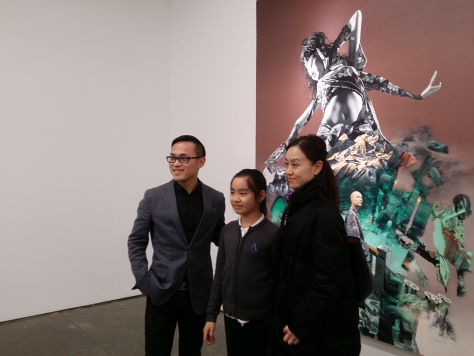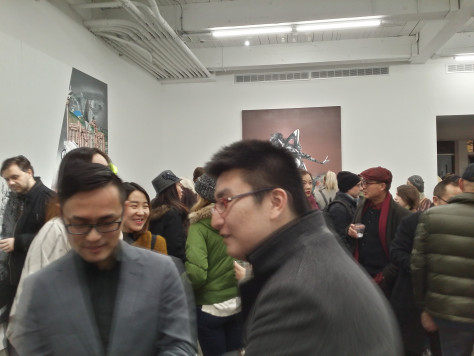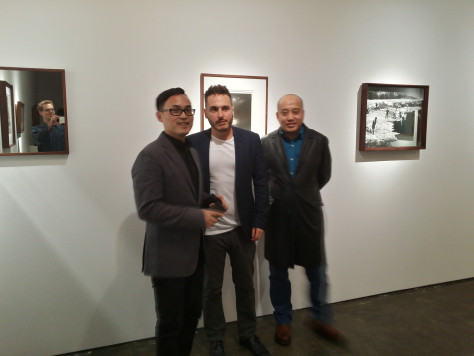On view now is Zhong Biao’s exhibition “The Other Shore.” In addition, there is an annex featuring recent work collectively titled “Fountain” 泉 of photographer, installation artist 蔡东东 (pictured with gallerist Eli Klein and Zhong above). Below is the essay I wrote for the catalogue.
Zhong Biao: “The Other Shore”
Zhong Biao’s exhibition “The Other Shore” refers in part to geography, in which a typical configuration sees China on one side, and the West on the other. In the case of the present exhibition at Klein Sun Gallery, Zhong is making his first appearance in New York, the “Other Shore” being relative to Beijing. In fact, in an interview in mid 2015, when the artist Zhong Biao was asked the following question: “Of all the cities in the world, in which would you choose to reside?” Zhong’s answer was:
New York, because the richness of this city brings with it a sense of security, a security that can fully accommodate my anxiety of choosing in the first place. This also illustrates the fact that ultimately, I have no idea what I really want from this life.[1]
Zhong’s preference for such global urban centers is connected to his process as an artist. These are places where the concentration of human activity is high enough to provide sufficient material for his work. In practice, this means that Zhong Biao’s paintings are created from images he collects from his own digital camera or from other print or digital media. This raw material is then rendered and collaged by hand in oil paint or acrylic, generating images which traverse space and time while retaining a hyper-realist accuracy. Expanses of blue sky frame hairs on human flesh. Bodies, whether corpulent or lithe, old or young, are arrayed in environments built or natural, usually painted in minute detail. The scale of his paintings is often very large, with his largest work Mirage (2009) reaching a width of fifteen meters. This scale enables viewers to travel on foot a path which flows from the quotidian to the cataclysmic and back again in a single image. The scenes Zhong depicts are familiar – historical events, financial upheaval, political vicissitudes, scandal. These references serve to locate us as viewers in our present circumstances. House of Cards (2015), for instance, brings to mind the 2016 US presidential contest, and Chinese Dream (2014), a political slogan recently invented by current leader Xi Jinping, brings us to China’s rather extraordinary rise to prominence on the world stage today, both in its successes and its challenges.
That said, to focus too narrowly on the thematic, symbolic, or articulable elements of Zhong’s work is a misstep. The geographical reading of Zhong’s “Other Shore” is therefore also limited. If there is one major theme which travels throughout his work, it is flight, whether of actual birds or of human figures in various states of levitation. The avian imagery carries with it its own set of symbolisms. Cranes – a symbol of longevity, among others –feature prominently in Zhong’s work, but we also see eagles, and even pigeons. The hawk in Take Off (2015), the Avalokiteshvara figure arising majestically out of Journey to the West, (2015), and the repeated image of a woman in flight seen throughout Velarium (2015), are prominent examples in this exhibition.
Nonetheless, after spending some time pursuing the more recognizable features of Zhong’s repertoire, we notice that he’s not entirely interested in these elements anyway, except, to quote the title of an early 20th-century Chinese poem, as a sort of “organization of distances.” This organization is to a degree topical and connected to our present moment. For example, in The Other Shore (2015), Palmyra, a recent casualty of ISIS aggression in Syria, occupies the upper right portion of the canvas. However, on closer examination, we see that Zhong’s juxtapositions are designed to reveal underlying forces that generate or at least flow through all the material forms. We see in the first place a universal pneuma (or “qi” 气, in Chinese parlance) that propels all matter forward in time. From this space, in other words, we move on to what is really “The Other Shore” in Zhong’s work: time. To be more precise, it is the problem of depicting time that has preoccupied Zhong Biao from a young age. As he recalled during a recent speech given at an exhibition in Beijing, the fact that perception of an event, even one taking place directly in front of us, still occurs milliseconds after the end of the occurrence, or that the light we see coming from a distant planet actually appear to our eyes thousands of years after the death of the planet, were entirely befuddling to him.[2] If, he continued in this speech, we consider time to be a cake, and we cut the cake in two, with the past on one side, and the future on the other, we find ourselves with nothing but a knife and emptiness.
It is also this preoccupation with time that drove Zhong, around the year 2006, to include abstract images in his work. The abstract strokes are depictions of the forces that pervade our phenomenal world, ever-present and yet not confined to linear sequence of spatial reality. This abstract element has also evolved notably as well as subtly in his work over the years. In earlier paintings, there were smooth swaths of color, executed with large brushes in a balletic process (Zhong works with an assistant who helps him move large canvases up and down as he quite literally dances and paints in front of them, often with thunderous musical accompaniment), further punctuated by drips. Those abstract forms were akin to the occasional video installations Zhong includes with his exhibitions, where hyperrealist images from paintings appear on a video screen, and then dissolve, with traces of recognizable figures giving way to completely abstract forms before reconstituting as new figures. More recently, the swaths have grown richer, more angular and three-dimensional, giving a sense of layered or parallel realities torn from one another, conjuring memory both recalled and ruptured. Houhai (2015) is an excellent example of the way Zhong now deftly weaves hyperrealism with complete abstraction, allowing him to challenge the limits of each in a single canvas.
In fact, the blend of figural and abstract is broadly emblematic of Zhong’s work, both as a painter and a thinker. His goal is to use painting to challenge the limits of space and time which frame our experience. Whether or not launching such a challenge fully answers his question as to what he wants to do with his life is an open question. As he works towards an answer, we have plenty to look at in the meantime.
[1] Bazaar Art and Fashion 芭莎艺术. “Artist Zhong Biao: Without Curiosity, There Is No Inspiration” (艺术家钟飙:不怀揣问号,还想泡灵感?). Interview, 25 Dec., 2015. Web.
[2] Zhong Biao. “Exhibition Closing Remarks,” Zhong Gallery 中画廊, Beijing. 15 Oct., 2015.



